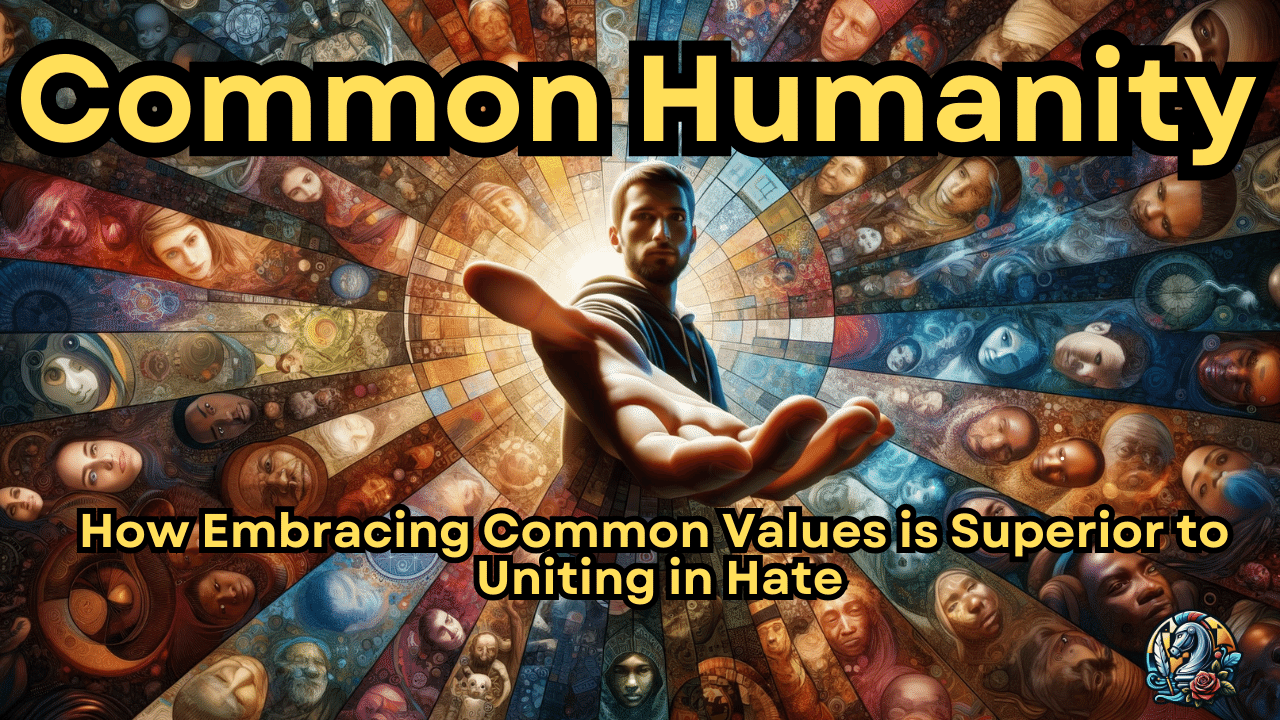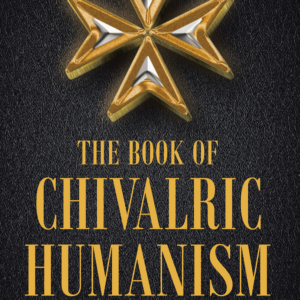The Common Humanity form of shared group identity construction is the logical conclusion of Enlightenment era philosophy and values. Common Humanity is the polar opposite ideological position of a Common Enemy approach. In contrast to Common Enemy frameworks, the Common Humanity approach offers a more enlightened and constructive perspective on diversity. This approach recognizes that, despite our differences, we are all interconnected through our shared human experience. It promotes unity by emphasizing the common bonds that link us as human beings. Rather than focusing on our divisions, the Common Humanity approach encourages us to celebrate the common values between diverse groups of people and learn from one another.
It is sometimes mistakenly said that Common Humanity is a “celebration of diversity” but this is a misunderstanding; diversity by its very nature is a comparison of what is different, not what is in common. Diversity simply for the sake of diversity nearly always brings strife and conflicts, but purposeful diversity can have its utilities. The most important thing for unification between people of different cultural backgrounds is to find common ground by identifying shared values that a new common identity can be built upon. This means one does not need a shared enemy in order to unite people together toward common goals, as what is bringing people together is their shared values they can respect in each other.
Embracing the Common Humanity approach invites us to engage in meaningful dialogue, cultivate empathy and build bridges of understanding among individuals from diverse backgrounds. This approach recognizes that our unique experiences and backgrounds can contribute to the tapestry of human existence, and it champions equality, justice and mutual respect for all.
There are occasions where republics and democracies before the Age of Enlightenment are considered to have formed some pseudo-Common Humanity approaches, such as the Greek states and the Roman Republic, as these were also multicultural countries that united large groups of people from different ethnic groups. The age of Enlightenment philosophers were deeply influenced by Hellenistic philosophers. However the Common Humanity approach goes further, as it relies heavily on a concept of liberty that requires the separation of church and state and advocates for the use of the scientific method and logic to investigate and form solutions to problems. Republics prior to this point in history practiced forms of democracy that relied heavily on superstitious and religious beliefs to support their rhetoric and decisions. Common Humanity is therefore dependent on the events of the Scientific Revolution that began in the 16th century.
As an example of how significant a problem that lacking separation of church and state is, we can look at several key events in history that illustrate how decisions by a government imposing religious will onto a population significantly shape the course of history in not altogether positive ways:
…in 1st CE the Jewish-Roman Wars were a result of Romans requiring Jews to pay homage to Roman patron deities, such as Jupiter. The Jews rose up in rebellion over this and the Romans retaliated by massacring the Jewish population of Jerusalem and its surrounding area, as well as capturing thousands as slaves which were brought to Rome. The Second Temple was demolished and replaced by a Temple to Jupiter. This devastated the Jewish population and resulted in its religious beliefs splintering into numerous factions, the two most dominant that survive today are Rabbinic Judaism and Christianity.
…. Christianity would go on to become the dominant religion of the Roman Empire due to the mandates of Roman Emperor Constantine I in the 4th CE, after he had converted to the religion. After Christianity became the new religion of the empire, the centuries old policy of Romans practicing tolerance of other religions (so long as the Roman state religion was also homaged) ended, and followers of other religions throughout the empire were persecuted and massacred. This also included branches of Christianity that did not conform to the consensus on uniform Christian dogma created by the Council of Nicaea in 325 CE. as well as Rabbinic Judaism. Governments that replaced the Roman Empire after its deterioration, such as the Byzantine Empire and the fragmented city-states and regional polities (Francia, the Italian Papal States, etc.), would continue the practice of religious persecution of non-Christian religious beliefs for centuries until Europe had stamped out almost all religious practice except that which was Christian.
…..New denominations of Christianity would emerge in Europe during the Renaissance (14th to 17th century CE) and Enlightenment period (17th to 19th century CE) as a consequence of Catholic orthodoxy (in particular, Scholasticism) agreed by the consensus of the general public to be indisputably erroneous (most critically, the revelation that the universe was heliocentric and that other planets did not revolve around the Earth as its center, as Scholasticists had insisted). The abandonment of Catholic orthodoxy propelled the adoption of Protestantism and many new branches of Protestantism were developed. Unfortunately, due to enormous disagreements between these differing forms of Protestantism and the older Roman Catholic orthodoxy, Europe would spend centuries engaged in wars largely as consequence of differing religious viewpoints, as the penchant for rulers to enforce their personal brand of Christianity onto those they governed persisted. It would not be until the end of the Enlightenment period that European countries would become secular, implementing legal policy that imposed religious toleration policies and provided a right to freedom of religious practice that this period of non-stop warfare in Europe would end.
It should be mentioned that a group adapting a Common Humanity framework is not necessarily pacific, although it can be. Common Humanity means that group identity is created through focus on shared universal values that can be identified as favored by the members of the group and that this is the principle focus of the uniting efforts. A Common Humanity group that values upholding of laws and maintaining social order through justice is still a Common Humanity group, even if force is used to uphold the laws and maintain social order, such as through arrests, suppression of revolts against its government or by using military force to defend against invasion of another country or even the attacking of a country believed to be threatening its interests. The essential thing for Common Humanity is that it does not devolve into Common Enemy justifications for violence. Even in instances where force must be used by Common Humanist group members against another group, the force must not be motivated by hatred. There is a fine line between justice and vengeance, and there is a difference between duty and reckless wrath. The use of force must be motivated by a sense of duty and the pursuit of justice rather than a desire for revenge.
Common Humanity also does not mean acceptance of all ideologies as legitimate. By its very nature Common Humanity must be the rejection of hatred as a unifying quality for group cohesion. By their nature Common Enemy groups can only thrive on fostering animosity towards others, and their ideology is therefore incompatible with the rules and policies of a Common Humanity based country that seeks to create a more inclusive and harmonious society. This means that when Common Enemy groups engage in acts of violence, crime and other violations of the lawful rights of others, Common Humanist nations must use police force to suppress these bad actors in order to prevent the escalation of social discord that Common Enemy groups create with these actions. Rehabilitation of the individual Common Enemy group members may be possible but it cannot be possible while the group is engaged in acts such as violence that create societal disorder and risk inspiring new kinds of Common Enemy groups to spring up in response with the intention to seek revenge for what the original Common Enemy group did.
This also means that a Common Humanity nation must carefully screen who it allows into that nation. Past generations understood that immigration needed to be controlled by a nation to ensure dissident populations did not enter and cause mayhem. Security concerns must be balanced with humanitarian values to ensure that immigration policies do not inadvertently perpetuate Common Enemy type discrimination or exclusion while simultaneously not permitting Common Enemy groups to take advantage of a country’s lax immigration policies in order to infiltrate and disrupt that country.
A Common Humanity framework is not static and it should evolve in response to changing circumstances and societal values. It should adapt to ensure that the rejection of hatred and the promotion of shared universal values remain at its core. For a nation practicing its ideals, striking the right balance between upholding laws and avoiding excessive use of force can be complex and requires careful ethical considerations when policymaking.
To date there has been no nation which has been wholly Common Humanistic. The closest a country has been to achieving this is the United States of America after the passing of the Civil Rights Acts in the 1960s. After the assassination of civil rights leader Martin Luther King Jr. his death was used as martyrdom to convince sweeping social changes at all levels of government and in the public education system to promote Common Humanity ideology to unite Americans together in shared national identity and to view ethnic heritage as a secondary status. Unfortunately the influence of black supremacy and separatist groups undermined this effort to establish a Common Humanity identity in America; black supremacist groups used racially segregated colleges to propagandize generations of African-American college students in black separatist Common Enemy rhetoric. These ideas became formalized as ‘Critical race theory’, ‘anti-racism racism’, Diversity Equity and Inclusion’ (DEI) and a few other misnomer names meant to give this rhetoric perceived legitimacy as genuine equality promotion when in fact they were racist by their very nature and intended only to recruit others into a Common Enemy framework against “white people”. These ideas have tainted the nation in the present day and caused renewed racial conflicts as black separatist ideologies have found renewed interest in younger generations. Furthermore these black separatist ideologies have been merged with gay rights activists in the so-called LGBTQ movement, which had also adopted another Common Enemy framework against “white” heterosexual Christian fundamentalists. There was a merging of the interests of LGBTQ and black separatist idealogies into a singular Common Enemy group in the 2010s which manifested itself as groups such as the Black Lives Matter, Antifa and Indivisible – groups which have enormous cross-over between one another in memberships with the common trait being pro Democratic party allegiances. These groups are directly opposed to the Common Humanity ideology that had been mainstream in America in the 1980s to the 2010s and these groups have been successful at terrifying many Americans into joining Common Enemy groups designed to oppose them, such as the Proud Boys, Q-anon conspiracy believers and other similar groups. This struggle is ongoing and unfortunately is, at present, very likely to escalate into the creation of a Common Enemy group that is so ideologically opposed to the mixture of gay rights and black separatism DEI ideology that a second American civil war occurs between both groups. It is my opinion that the only way this can be avoided is if instead of forming a new Common Enemy group, the targets of the DEI Common Enemy group (heterosexual Caucasian political conservatives) instead form a Common Humanity group that is able to successfully absorb the members of the DEI Common Enemy group to extinguish its ability to spark such a war. My purpose of writing this book has been to convince people in America to create such a group in order to avoid the collapse of the country into civil war.
In conclusion, the Common Enemy and Common Humanity approaches represent two fundamentally distinct ways of addressing diversity and identity construction. While the Common Enemy approach perpetuates division, prejudice, and hatred, the Common Humanity approach stands as a beacon of hope, championing unity, inclusivity and the celebration of our shared human experience. It is our collective responsibility to reject the destructive forces of racism and discrimination and embrace the principles of our common humanity, fostering a world where common values can be found between diverse peoples and all individuals are treated with the respect and dignity they deserve. Only by doing so can we hope to build a more just, equitable, and harmonious society for all.
In a world where Common Enemy groups continue to proliferate, it is incumbent upon individuals and society as a whole to remain vigilant, promote rational discourse and counteract the spread of unfounded beliefs. Only through a concerted effort to address the root causes of the susceptibility to hatred can we hope to combat the pervasive influence of Common Enemy groups and promote the ideals of Common Humanity in their stead.



